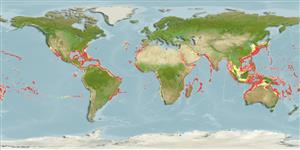>
Aulopiformes (Grinners) >
Notosudidae (Waryfishes)
Etymology: Scopelosaurus: Greek, skopelos = a lantern fish + Greek, sauros = lizard (Ref. 45335).
Environment: milieu / climate zone / depth range / distribution range
Οικολογία
Θαλασσινό(ά) βενθοπελαγικό; ωκεανόδρομο(ς) (Ref. 6689); εύρος βάθους 50 - 815 m (Ref. 13608). Tropical; 40°N - 30°S
Eastern Atlantic: off Madeira and at 20°N 30°W. Western Atlantic: 34°N to 20°S, with some larval drift up to 40°N. Elsewhere, Indian and Pacific Oceans between 20°N and 30°S.
Μέγεθος / Βάρος / Age
Maturity: Lm ? range ? - ? cm
Max length : 25.0 cm TL αρσενικό/απροσδιόριστο; (Ref. 6602)
Short description
Μορφολογία | Μορφομετρία
Ραχιαίες άκανθες (συνολικά): 0; Μαλακές ραχιαίες ακτίνες (συνολικά): 10-12; Εδρικές άκανθες 0; Μαλακές εδρικές ακτίνες: 17 - 19; Σπόνδυλοι: 53 - 56. Blackish on head and back; paler below (Ref. 6602). No distinct black spot surrounding anus (Ref. 13608).
Larvae are epipelagic, young inhabit the layers between 50-200 m, adults benthopelagic and found deeper than 500 m over continental and insular slopes (Ref. 6552, 6602). Mesopelagic (Ref. 58302). Feeds mainly on zooplankton. Extensive migrations by juveniles and adults, probably for feeding in the subtropical belts. Spawning occurs in tropical waters, especially in the western part of the Atlantic Ocean (Ref. 6689).
Life cycle and mating behavior
Γεννητική Ωρίμανση | Αναπαραγωγή | Γεννοβολία | Αβγά | Γονιμότητα | Προνύμφες
Krefft, G., 1990. Notosudidae. p. 361-364. In J.C. Quero, J.C. Hureau, C. Karrer, A. Post and L. Saldanha (eds.) Check-list of the fishes of the eastern tropical Atlantic (CLOFETA). JNICT, Lisbon; SEI, Paris; and UNESCO, Paris. Vol. 1. (Ref. 6552)
IUCN Red List Status (Ref. 130435)
Threat to humans
Harmless
Human uses
αλιεία: χωρίς ενδιαφέρον
Περισσότερες πληροφορίες
Κοινά ονόματαΣυνώνυμαΜεταβολισμόςΘηρευτέςΟικοτοξικολογίαΑναπαραγωγήΓεννητική ΩρίμανσηΓεννοβολίαΣυναθροίσεις γεννοβολίαςΓονιμότηταΑβγάEgg development
Age/SizeΑύξησηLength-weightLength-lengthLength-frequenciesΜορφομετρίαΜορφολογίαΠρονύμφεςΔυναμική προνυμφώνΣτρατολόγησηΑφθονίαBRUVS
ΑναφορέςΥδατοκαλλιέργειεςΠροφίλ υδατοκαλλιέργειαςΣτελέχοιΓενετικήElectrophoresesΚληρονομικότηταΑσθένειεςΜεταποίησηNutrientsMass conversion
ΣυνεργάτεςΦωτογραφίεςStamps, Coins Misc.ΉχοιΣιγκουατέραΤαχύτηταΚολυμβητικός ΤύποςΕπιφάνεια βραγχίωνOtolithsΕγκέφαλοιΌραση
Εργαλεία
Special reports
Download XML
Διαδικτυακές πηγές
Estimates based on models
Preferred temperature (Ref.
123201): 9.6 - 20.6, mean 14.5 °C (based on 680 cells).
Phylogenetic diversity index (Ref.
82804): PD
50 = 0.5001 [Uniqueness, from 0.5 = low to 2.0 = high].
Bayesian length-weight: a=0.00288 (0.00120 - 0.00692), b=3.18 (2.96 - 3.40), in cm total length, based on LWR estimates for this (Sub)family-body shape (Ref.
93245).
Τροφικό Επίπεδο (Ref.
69278): 3.4 ±0.45 se; based on food items.
Fishing Vulnerability (Ref.
59153): Low vulnerability (15 of 100).
